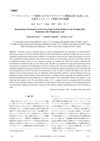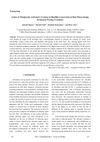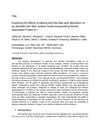TLDR Bleaching hair increases cysteic acid levels in a predictable way.
The study evaluated cysteic acid generation in bleached human hair using infrared spectroscopy. Results indicated that cysteic acid levels increased linearly with the square root of bleaching time, suggesting a diffusion-controlled reaction. This behavior was observed in both the cuticles and cortex of the hair, with higher disulfide crosslink density and slower hydrogen peroxide diffusion rates in the A-layer and exocuticle. Infrared microscopic measurements confirmed even cysteic acid distribution within the cortex, implying that hydrogen peroxide diffusion from the cell membrane complex into cortical cells controlled cysteic acid generation.
 3 citations
,
January 2015 in “Sen i Gakkaishi”
3 citations
,
January 2015 in “Sen i Gakkaishi” The new keratin film without KAPs stains better and could help study keratin functions.
 2 citations
,
January 2015 in “Sen'i Gakkaishi”
2 citations
,
January 2015 in “Sen'i Gakkaishi” Washing permed hair after using thioglycolic acid helps reform strong bonds, making hair stronger.
 18 citations
,
January 2008 in “Sen'i Gakkaishi”
18 citations
,
January 2008 in “Sen'i Gakkaishi” Thioglycolic acid and L-cysteine change hair structure differently during perms, affecting hair strength and curling efficiency.
56 citations
,
January 1977
 5 citations
,
May 2022 in “Fashion and Textiles”
5 citations
,
May 2022 in “Fashion and Textiles” Hair conditioners with argan oil or camellia oil improve the strength and color of bleached hair.
 February 2025 in “International Journal of Cosmetic Science”
February 2025 in “International Journal of Cosmetic Science” Protein carbonylation is a sensitive marker for oxidative damage in hair, especially from light exposure.

Understanding hair surface properties is key for effective hair care products.
 April 2024 in “Advances in Redox Research”
April 2024 in “Advances in Redox Research” Human hair strength and health are linked to sulfur compounds that can be reduced by stress but improved with sulfur supplements.

Water and fatty acids affect hair's surface differently based on hair damage, and models can help understand hair-cosmetic interactions.








